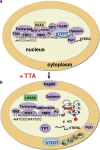Telomerase and its potential for therapeutic intervention
- PMID: 17603541
- PMCID: PMC2095101
- DOI: 10.1038/sj.bjp.0707374
Telomerase and its potential for therapeutic intervention
Abstract
Telomerase and telomeres are attractive targets for anticancer therapy. This is supported by the fact that the majority of human cancers express the enzyme telomerase which is essential to maintain their telomere length and thus, to ensure indefinite cell proliferation--a hallmark of cancer. Tumours have relatively shorter telomeres compared to normal cell types, opening the possibility that human cancers may be considerably more susceptible to killing by agents that inhibit telomere replication than normal cells. Advances in the understanding of the regulation of telomerase activity and the telomere structure, as well as the identification of telomerase and telomere associated binding proteins have opened new avenues for therapeutic intervention. Here, we review telomere and telomerase biology and the various approaches which have been developed to inhibit the telomere/telomerase complex over the past decade. They include inhibitors of the enzyme catalytic subunit and RNA component, agents that target telomeres, telomerase vaccines and drugs targeting binding proteins. The emerging role of telomerase in cancer stem cells and the implications for cancer therapy are also discussed.
Figures



Similar articles
-
Telomerase Inhibitors from Natural Products and Their Anticancer Potential.Int J Mol Sci. 2017 Dec 21;19(1):13. doi: 10.3390/ijms19010013. Int J Mol Sci. 2017. PMID: 29267203 Free PMC article. Review.
-
Overcoming the immortality of tumour cells by telomere and telomerase based cancer therapeutics--current status and future prospects.Eur J Cancer. 2005 May;41(7):971-9. doi: 10.1016/j.ejca.2004.11.024. Eur J Cancer. 2005. PMID: 15862745 Review.
-
Anticancer therapy targeting telomeres and telomerase : current status.BioDrugs. 2007;21(6):375-85. doi: 10.2165/00063030-200721060-00005. BioDrugs. 2007. PMID: 18020621 Review.
-
Telomeres and telomerase: Pharmacological targets for new anticancer strategies?Curr Cancer Drug Targets. 2006 Mar;6(2):147-80. doi: 10.2174/156800906776056482. Curr Cancer Drug Targets. 2006. PMID: 16529544 Review.
-
[Inhibition of telomeres and telomerase. Seeking for new anticancer drugs].Bull Cancer. 1997 Dec;84(12):1123-33. Bull Cancer. 1997. PMID: 9587365 Review. French.
Cited by
-
Altered mRNA expression of telomere-associated genes in monoclonal gammopathy of undetermined significance and multiple myeloma.Mol Med. 2010 Nov-Dec;16(11-12):471-8. doi: 10.2119/molmed.2010.00057. Epub 2010 Jul 14. Mol Med. 2010. PMID: 20644899 Free PMC article.
-
A Cas6-based RNA tracking platform functioning in a fluorescence-activation mode.Nucleic Acids Res. 2022 May 6;50(8):e46. doi: 10.1093/nar/gkac014. Nucleic Acids Res. 2022. PMID: 35061906 Free PMC article.
-
The effects of chitosan-loaded JQ1 nanoparticles on OVCAR-3 cell cycle and apoptosis-related gene expression.Res Pharm Sci. 2024 Feb 6;19(1):53-63. doi: 10.4103/1735-5362.394820. eCollection 2024 Feb. Res Pharm Sci. 2024. PMID: 39006975 Free PMC article.
-
Blood-Derived Exosomal hTERT mRNA in Patients with Lung Cancer: Characterization and Correlation with Response to Therapy.Biomedicines. 2023 Jun 16;11(6):1730. doi: 10.3390/biomedicines11061730. Biomedicines. 2023. PMID: 37371825 Free PMC article.
-
Characterisation of blood-derived exosomal hTERT mRNA secretion in cancer patients: a potential pan-cancer marker.Br J Cancer. 2017 Jul 25;117(3):353-357. doi: 10.1038/bjc.2017.166. Epub 2017 Jun 22. Br J Cancer. 2017. PMID: 28641311 Free PMC article.
References
-
- Armanios M, Greider CW. Telomerase and cancer stem cells. Cold Spring Harb Symp Quant Biol. 2005;70:205–208. - PubMed
-
- Bisoffi M, Heaphy CM, Griffith JK. Telomeres: prognostic markers for solid tumours. Int J Cancer. 2006;119:2255–2260. - PubMed
-
- Blackburn EH. Structure and function of telomeres. Nature. 1991;305:569–573. - PubMed
-
- Blackburn EH. Telomerases. Annu Rev Biochem. 1992;61:113–129. - PubMed
-
- Blackburn EH. Telomere states and cell fates. Nature. 2000;408:53–56. - PubMed
Publication types
MeSH terms
Substances
LinkOut - more resources
Full Text Sources
Miscellaneous

